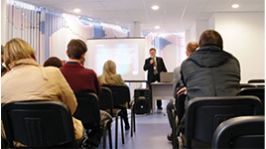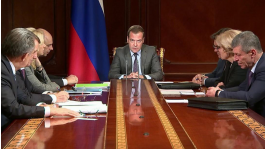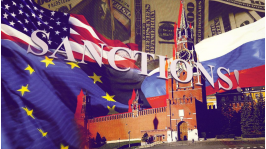The present economic reform is intended to radically transform the economic structure and, consequently, the system of employment. This, in turn, requires a substantially modified structure and level of personnel training. More attention at every stage should be paid both to the current demand for labor and to Russia’s prospective economic development. The existing state of affairs is presently unsatisfactory.
Labor may be skilled or unskilled. It is clear that the smaller the volume and relative portion of unskilled labor, the more flexible the market and its potential and real opportunities for adapting to changing requirements will be. Therefore, we believe it is necessary to begin studying the mechanisms of workplace functioning by identifying the level of skill of the personnel filling the market every year. We will use simple approaches based on balanced correlations to deal with this problem.
The object of our study will be two autonomous flows of personnel, composed both of those who graduated from high school and of those who have incomplete high school educations. In turn, we break down each flow into four groups: graduates who enter industrial trade schools (ITSs); graduates who join specialized secondary schools (SSSs); students who continue their studies at high schools, or enter institutions of higher education (IHE); and students who drop out to find employment in the free workplace. Members of the last group are the least trained in any trade or skill.
Our balance correlations are as follows:
 (1)
(1)
 (2)
(2)
where SUM – total number of graduates; IHS – those with  incomplete high school educations; CS – students continuing studies at high schools; WF – work force; CHS – students who complete high school.
incomplete high school educations; CS – students continuing studies at high schools; WF – work force; CHS – students who complete high school.  and
and  are the number of those who have finished incomplete and complete high schools;
are the number of those who have finished incomplete and complete high schools;  and
and  are the number of those who entered ITSs after finishing incomplete and complete high schools.
are the number of those who entered ITSs after finishing incomplete and complete high schools.  and
and  are the number of those who entered SSSs after finishing incomplete and complete high schools;
are the number of those who entered SSSs after finishing incomplete and complete high schools; .png) are the number of students continuing studies at high schools;
are the number of students continuing studies at high schools;  are the number of high school graduates who entered IHE; and
are the number of high school graduates who entered IHE; and  and
and  are the number of those with incomplete and complete high school educations who go to work. The total number of unskilled labor that joins the work force is obtained as follows:
are the number of those with incomplete and complete high school educations who go to work. The total number of unskilled labor that joins the work force is obtained as follows:  where UL is unskilled labor.
where UL is unskilled labor.
Thus, at every stage of education, schools discharge a certain large quantity of graduates into the workplace. Synchronized, two such discharges significantly add to the army of unskilled labor. Calculations according to equations (1) and (2) indicate that the share of unskilled school boys and girls employed in Russia in 1985 comprised 0.4 percent of the total employment. In 1990 and 1991, this share increased. In the past eight years graduates with a complete high school education increasingly and steadily followed the example of their junior mates with incomplete high school education (Tables 1 and 2) [1]. Although this process is natural (to replace and replenish unskilled labor is a regular practice in the national economy), it may entail negative consequences stemming from the low capacity of this labor category to adjust to the changing working conditions and the demand for a certain type of work. This group of the population is most vulnerable: members may be out of a job, or even become chronically unemployed. And, although the scope of this phenomenon is not yet large, the fact that most high–school students are not interested in continuing their studies disturbs us greatly. The Goskomstat (State Committee for Statistics) estimates that every fourth teenager aged 14–16 thinks of studies as forced on him or her. One–third of students describe their relations with the teaching staff as hostile [1].
Table 1. Distribution of those with incomplete high school educations by types of further activity, thousands, percent

Table 2. Distribution of high school graduates by type of further activity, thousands, percent
|
|
1985 |
1990 |
1991 |
|||
|
Number of high school graduates; out of them: |
925 |
100.0 |
910 |
100.0 |
959 |
100.0 |
|
– accepted by ITSs |
238 |
27.7 |
234 |
25.7 |
233 |
24.2 |
|
– accepted by SSSs |
173 |
18.7 |
171 |
18.8 |
179 |
18.7 |
|
– entered institutions of higher learning |
253 |
27.4 |
237 |
26.0 |
254 |
26.5 |
|
– joined the workplace |
261 |
26.2 |
268 |
29.5 |
293 |
30.6 |
Let us consider in greater detail the educational structure of skilled labor that annually fills vacancies in public production. For this purpose we will again use the balance techniques. In its general form, the annual workplace balance is as follows:  . Its extended form is the following:
. Its extended form is the following:
 (3)
(3)
where TI – total inflow of young people into the work force;  is the total inflow of young people to the work force;
is the total inflow of young people to the work force;  the quantity of skilled labor in the
the quantity of skilled labor in the  which consists of ITS (
which consists of ITS ( ), SSS (
), SSS ( ), and IHE graduates (
), and IHE graduates ( ), and postgraduates (PGs) (
), and postgraduates (PGs) ( ).
).
Table 3 presents calculations concerning the skilled part of young people (minus postgraduates). As we can see, the number of ITS graduates in 1991 was twice as large as SSS graduates, and three times as large as university and college graduates. Seventy–one and a half percent of all ITS–trained students learned an industrial trade. In other words, industrial training is a persisting syndrome. This is connected with the general orientation of Russia’s economy toward the quick growth of material production. In the 1990s, therefore, this sector was greatly over–employed. The planned changes in the educational system are for the time being very insignificant. Considering the specifics of this sector, radical structural changes are hardly to be expected in the near future.
Table 3. The structure of Russia’s system of education and training
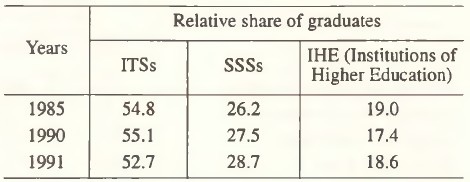
The slow reduction by the ITSs of their capacities is a serious source of unemployment because the present inflexible system of industrial training continues to supply the market with an increasing quantity of narrowly specialized, noncompetitive labor. As for the supply of labor that is more in demand, that is, labor versed in mass and priority skills, much has to be improved: textbooks and manuals are missing; the necessary materials and methodology to teach about 400 trades and skills are missing [1]; and students are dissatisfied with the quality of instruction. The sociological surveys requested by the Russian Federation’s Ministry of Education indicate that the educational and training establishments are not well oriented professionally; as they continue to use their old curricula, they are becoming more and more uncertain of their future. This is not surprising. The unwanted labor that these establishments graduate undermines the workplace’s stability.
Thus, the weakest link in Russia’s system of personnel training is, undoubtedly, the industrial–trade schools. As efforts are made to expand the nonproductive sphere (services), a larger SSS enrollment at the expense of ITSs would be beneficial.
Let us consider the industrial or sectoral structure of graduates from the respective schools. In this case, the balance of skilled labor for the market will assume the following form:
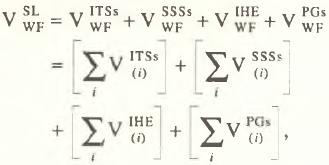 (4)
(4)
where i is the index of industry for which specialists are trained. The industry balances for graduates of high school and institutions of higher education are given in Tables 4 and 5 (the changing industry structure of postgraduates is illustrated and considered in [4]).
Table 4. Industry (sectoral) structure of specialized secondary schools
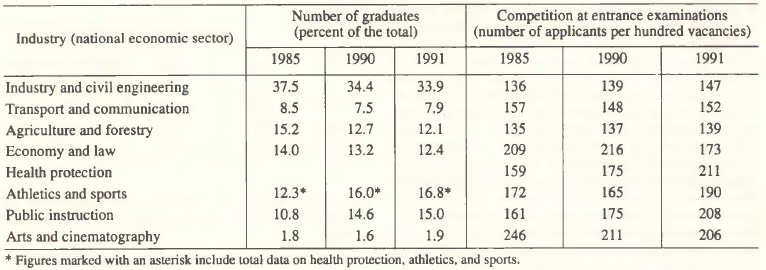
Table 5. Industry (sectoral) structure of institutions of higher learning
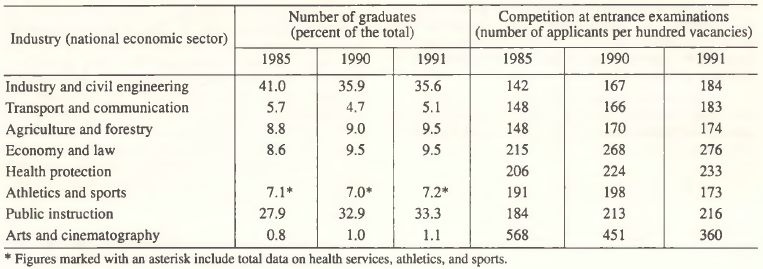
As we see, specialists are trained overwhelmingly by industries of material production. Their share in 1991 exceeded 40 percent of all SSS and IHE graduates. In other words, the aforesaid industrial syndrome is present in all systems of personnel training in the Russian economy.
The industry imbalance in training skilled labor causes great tension in the workplace. Although in 1985 – 1991 specialists of the nonproductive sphere were redistributed, the relative weight of the material–production industries constituted about 54 percent in SSSs and about 48 percent in IHE. This means that: (1) the system of personnel training clearly fails to correspond to the existing needs and is lagging behind the changing labor demand; and (2) this lag is wider at SSSs (specialized secondary schools) than at IHE (institutions of higher education). On the whole, the higher the educational status of schools, the lesser the deficit of specialists in the nonproductive economic sectors.
Information on applicants competing for admission to schools is an important addition to the considered balances. Although recently the demand for industrial trades has been shrinking, competition for these specialities continues to increase at SSSs, universities, and colleges (Tables 4 and 5). The situation sometimes becomes paradoxical: SSSs graduate fewer economists and lawyers, and competition for these professions decrease, whereas Russia’s economy is undersupplied in these fields of employment. This indicates that, despite the objectively changing demand, young people persist in their old, subjective preferences. Obviously, this is explained by the fact that the professional structure of labor demand is generally unstable, and some regions are still promoting and expanding monoproduction, thus disorienting young people choosing professions.
Information on the competition among applicants and the issue of graduates makes it easier to understand the emergence of an imbalanced workplace. The mechanism of this market may be described as follows.
The unreasonable structure of the Russian economy causes tension in the commodity markets. In order to lessen the supply–and–demand inconsistency, it is necessary to modify the existing structure of production, which will objectively entail an altered employment structure. Interindustry labor displacements increase unemployment. In a similar situation, it is essential, above all, to radically reform the personnel–training structure; otherwise, the new inflow of “unwanted” specialists will intensify unemployment. The said reforms warrant reformation of educational and training establishments: the respective departments of study and specialities within the framework of existing structures should be closed down and simultaneously replaced by new facilities.
All this is quite natural, although the process involves a certain amount of social spending. In the 1970s, the United States, for example, shut down 170 old universities and colleges to open 300 new ones in their place [5]. In Russia, however, this process is slow because applicants in great numbers assail those schools and departments (trades, skills, and professions) that are no longer needed and should be eliminated. In our opinion, the publication of a series of special bulletins with detailed information on the supply and demand of labor could quickly dispel the doubts of the young concerning the choice of a profession.
For a more exact study of workplace tendencies, it is worthwhile to analyze the inflow  in terms of basic trades and professions. For this purpose, we may use a balanced equation similar to the previous one:
in terms of basic trades and professions. For this purpose, we may use a balanced equation similar to the previous one:
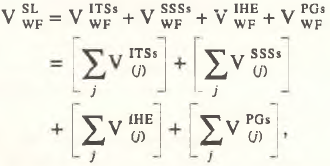 (5)
(5)
where j is the index of the investigated categories of specialists. Balance (5) helps form tables similar to Tables 4 and 5. The possible majors for college and university students number 30, whereas SSS graduates may learn 33 trades and professions.
Let us consider some tendencies in the personnel–training system from the point of view of the graduates’ professional structure.
Let us begin with the institutions of higher learning. In 1985 – 1991, the relative share of graduates in sciences fell from 9.2 to 8.4 percent which, in our view, reflects the general crisis of Russian science and research. A similar situation was observed in the humanities in 1990 – 1991, whose share dropped from 12.2 to 10.7 percent, although in the preceding years a contrary tendency prevailed. The year 1992 again witnessed a rising interest in the humanities. Notably, only three out of 22 universities and colleges opened in 1992 taught science and technology; the rest specialized in the humanities. The reason was that our engineering and technical staff was too large. In the 1990s, this redundancy began to gradually dissolve as the personnel–training system was reoriented to the humanities. However, even today we have too many engineers and technicians, e.g., in the late 1980s and the early 1990s, their portion among university graduates fluctuated from 10 to 20 percent. In Russia, the respective figure was 30 – 35 percent. The situation is exacerbated by the over–concentration of engineers: in 1990, the relative share of engineers in total employment in Russia amounted to 5.2 percent (as against only 1.6 percent in the United States).
From 1985 to 1991, the share of graduates in electronics, and instrument–making rose by 0.1 percent, which in terms of modem labor division is insignificant. In 1985 – 1988, the number of engineers in computer technology and automation systems registered a relative increase, but in the next two years this indicator fell again. A similar picture is characteristic of automatics and control, radio engineering and communication, and electronics: from 1985 to 1991 the respective indicators in these industries diminished as follows (percent): from 3.0 to 2.8; from 3.2 to 3.0; and from 1.1 to 0.7. These figures are very disturbing because it is specialists in these lines that are responsible for achieving technological breakthroughs in the Russian economy.
The following figures also fail to inspire optimism: during 1985 – 1991, the turnout of specialists in chemical technologies diminished by 1.5 percent: the number of graduates in civil engineering and architecture fell by 1.6 percent. In 1990 – 1991, the portion of technologists in the field of consumer goods remained intact, whereas the share of technologists in foodstuffs went down by 0.1 percent.
The above negative tendencies are unfolding in an unfavorable social and psychological climate. According to social surveys, only 10 percent of young people believe that the success of their professional career depends on their educational level. The social preferences of contemporary students are as follows: 6 percent would like to work in the Academy of Sciences’ institutions; 4 percent, in departmental research institutes; 33 percent, in joint ventures; 18 percent, in joint–stock companies; 17 – 21 percent plan to emigrate from Russia upon graduating from colleges and universities; 30 percent have already negotiated this point with foreign .representatives; and two–thirds of all students would like to go abroad for temporary employment [6]. Unreasonable use of the educational potential also minimizes the efficiency of the personnel-training system, e.g., 42 percent of young people with university education employed in the sphere of material production are assigned jobs intended for lesser skilled specialists, people with high school or specialized secondary school education [1].
In many respects, the changes in the system of specialized secondary education are identical with those in the system of higher education. In 1985 – 1991, specialists graduating in electrical engineering decreased from 2.2 to 2.0 percent. The number of graduates in many individual trades and professions fell as follows (percent): instrument–making and maintenance of instruments and equipment, 0.7 – 0.6; radio engineering and communication, 2.9 – 2.3; chemical technology, 1.4 – 1.2; foodstuffs technology, 1.4 – 1.3; consumer goods technology, 2.2 – 1.9; and architecture and civil engineering, 6.5 – 4.9. There was an invariable reduction in the relative portion of graduates in economics, planning, and marketing, and a small but steady decrease of specialists in ecology and environmental protection. Among the positive features consistent with the market economy was a twofold increase in the training of specialists in documentation science, as well as an increase in automation systems and their operation and maintenance (from 2.3 to 2.9 percent).
Thus, changes in the professional structure of personnel trained by the systems of specialized secondary and higher education were, on the whole, depressive; they contributed to the further slowdown of economic growth by suppressing personnel training for priority sectors of the national economy. The “dying away” of vital trades and professions identified with scientific, technological, and social progress was concomitant with the hyper–atrophied sphere of material production.
In addition to the long–term negative effects, the current structure of supply is lagging behind the existing structure of demand. According to the nonstate employment service, “Triza”, the disbalance between labor supply and demand in 1992 was as follows: the supply (relative share of received questionnaires to the total volume) was 11.4 percent, whereas the labor demand (relative share of applications to the total volume) comprised 25.0 percent. The respective figures in other individual professions were the following (percent): book–keeping, finances and economy, 23.7 and 18.0; stock exchange and brokers, 10.1 and 6.0; administration and management, 8.1 and 6.0; civil engineering and construction activity, 9.5 and 25.0; secretaries, translators, and interpreters, 19.3 and 5.0; transport specialists, 8.9 and 6.0; lawyers, 3.3 and 4.0; and other skills and professions, 5.7 and 5.0. The demand for skilled labor, construction workers, and lawyers was unsatisfied. The personnel–training network has so far been unable to train and supply these specialists in the required quantities. To a certain extent, this inadequacy can be explained by the fact that up until recently the personnel–training system was instructed to meet centralized applications, which in many cases failed to reflect the existing labor demand. The objective forecasts based on market research were practically disregarded.
The reviewed structure of skilled labor that annually go to the Russian workplace is somewhat deformed by the presently functioning system of personnel training. In the last 6 – 7 years, the following negative tendency has gained ground. In 1985, 4434 million men and women were trained and retrained in second trades, skills, and professions. In 1990 and 1991, the respective figures dropped to 3219 and 2738 million. This intense slump in labor retraining in the context of large-scale structural economic changes is a serious cause for concern. Similar negative phenomena affected the process of raising the skills of the working labor. In 1985, refresher courses were organized for 24657 million working men and women. In 1990, their number decreased to 17178 million only to fall to 7005 million in 1991. And, although in the past refresher training was frequently formal, the above steep fall in this activity now reveals utter carelessness in the present grave economic situation.
In 1992, professional training and retraining were mainly intended for the unemployed population. This year the Federal Employment Service provided training facilities for 27 800 applicants. Sixty four percent of them are women. The matrix structure of the sources and types of professional training is demonstrated in Table 6.
Table 6. The structure of training and retraining the unemployed population in 1992, percent
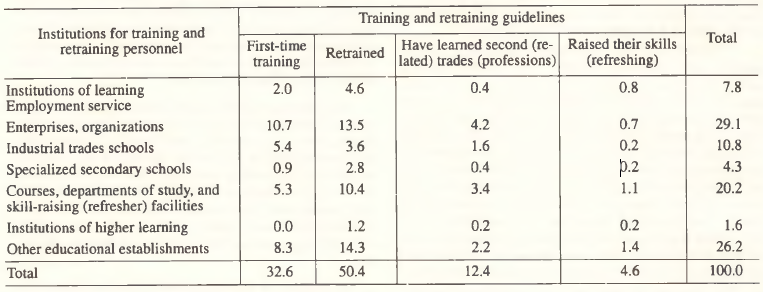
Usually, when we consider an open economy, the balance (6) should include the following migration mobility:
 (6)
(6)
where MIG – migration work force; MLR – migration of labor into Russia; and  and
and  represent, respectively, the number of migrating unskilled and skilled laborers to Russia (this balance reflects only the inflows of laborers because the outflows from
represent, respectively, the number of migrating unskilled and skilled laborers to Russia (this balance reflects only the inflows of laborers because the outflows from  and
and .png) cannot be practically reflected from a purely informational point of view). This inclusion of labor flows between countries substantially adds to and makes more accurate the understanding of the situation forming in the workplace. All the cited balances fit harmonically into the total balance of the employed population:
cannot be practically reflected from a purely informational point of view). This inclusion of labor flows between countries substantially adds to and makes more accurate the understanding of the situation forming in the workplace. All the cited balances fit harmonically into the total balance of the employed population:
 (7)
(7)
where t is the time index (year); V is the number of gainfully employed in the Russian national economy;  is the number of laborers exiting by the beginning of the next year for various reasons; and
is the number of laborers exiting by the beginning of the next year for various reasons; and  is the number of workers emigrating from Russia. The total contribution of the latter indicator becomes increasingly tangible. Thus, in 1989 – 1991 alone, the Russian workplace lost about 200 000 high–class specialists [6].
is the number of workers emigrating from Russia. The total contribution of the latter indicator becomes increasingly tangible. Thus, in 1989 – 1991 alone, the Russian workplace lost about 200 000 high–class specialists [6].
In conclusion, let us briefly discuss the workings of the personnel–training system from the “inside.” In other words, let us attempt to describe this system as it is, and the changes it is now undergoing.
On the whole, the position of national education is rather controversial. For one year, i.e., from November 1991, the employment in this sphere increased by 225000 men and women. Meanwhile, the research and teaching staff of Russia’s universities has decreased more than twice in the past five years. An authoritative approach still persists in pedagogics. Notably, sociological polls indicate that 62 percent of high school teachers and 31 percent of university and college professors believe that if the young are unwilling to study, they should be made to [1]. The financial position of educators has greatly deteriorated: in the first part of 1192 their relative pay comprised 69 percent of the average national salary and wage, i.e., a fall of 20 percent as against the first part of 1991. As a result, the instructional level is falling. Fifty–seven percent of university rectors evaluate the professional competence of their staff as unsatisfactory [1].
Recent years have witnessed the mushrooming of nonstate schools – private, municipal, religious, etc. They also include elite high schools and lyceums whose role is, however, still insignificant: the relative share of students in these institutions in 1991 – 1992 was only 1.7 percent [2] (Cf. 10 – 15 percent at private American schools). Many former state schools are being reorganized into colleges (including private colleges). We believe that this process should be encouraged, as it helps relieve the federal budget of at least a part of its financial burden.
Our “through” analysis of all the basic links of the national personnel–training system makes it possible to illuminate the situation as a whole in this area, as well as to elucidate some specific features of Russia’s modem economic development. The results of our study show that the government and its departments, in their efforts to deepen the economic reform, should focus on labor resources, which thus far remain in the background.
REFERENCES
1. Alekseenkov, S., Baranov, S., and Nevar, S., Young People: Who Wants Them? Nezavisimaya Gazeta, March 3, 1993.
2. Obrazovanie i Kul’tura v Rossiiskoi Federatsii (Education and Culture in the Russian Federation), Moscow: Respublikanskii Informatsionno–Izdatel’skii Tsentr, 1992.
3. Narodnoe Khozyaistvo Rossiiskoi Federatsii. Statisticheskii Ezhegodnik (The RF National Economy. A Statistical Yearbook), Moscow: Respublikanskii Informatsionno–Izdatel’skii Tsentr, 1992.
4. Balatskii, E. V., Bogomolov, Yu.P., How to Preserve Russia’s Intellectual Potential? Herald of the Russian Academy of Sciences, 1993, no. 6.
5. Martsinkevich, V.I., SShA: Chelovecheskii Faktor i Effektivnost’ Ekonomiki (USA: the Human Factor and Economic Efficiency), Moscow: Nauka, 1991.
6. Gol’dman, I., The Stars Fall Down Overseas, Delovoi Mir, April 21, 1993.
7. Sotsiologicheskii Portret Uchashchegosya PTU (The Sociological Portrait of a ITS Student), Min. Obrazovaniya RF, 1992.
[1] The data in Tables 1 – 5 are estimated from [2, 3].
Official link to the article:
Balatskii E.V., Bogomolov Yu.P. Personnel Training// «Herald of the Russian Academy of Sciences», 1993, Vol.63, no.11, pp.843–849.

